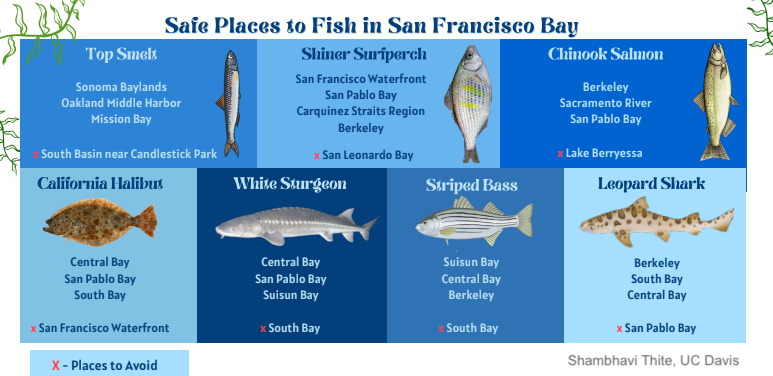San Francisco Bay Data Exploration Challenge
Date:
August 17, 2020 - 12:00am to November 27, 2020 - 12:00am
In 2020 the Bay RMP held its third Data Exploration Challenge, a contest prompting high school and university-level students to explore data available in SFEI's publicly available database - CD3. Participants were presented with a number of specific prompts related to a public health scenario to identify Bay fishing areas with the lowest exposure to mercury and PCBs by examining concentrations in Bay fish tissue and sediment.
The contest received four submissions and after consideration by the Bay RMP Technical Review Committee (TRC), all were awarded prizes. These went to a high school student, two undergraduate university students, and a PhD candidate. The submissions contained data visualizations with unique graphics and careful consideration of the intended audience.
 |
 |
 |
 |
| 1st Place (High School): Elianna Kondylis, The Nueva School | 1st Place (University): Lesley Huang, Cornell University | 2nd Place (University): Lealia Xiong, CalTech | 3rd Place (University): Shambhavi Thite, UC Davis |
Due to a low number of submissions in all three years of the contest in spite of increased outreach effort, the TRC decided to retire the Challenge for the foreseeable future. However, RMP staff will maintain the connections established with teachers and professors and update them on any CD3 developments and data uploads.
To protect the health of Bay Area anglers and their families, participants were asked to identify the safest places to go fishing, with the lowest exposure to mercury and PCBs. Using provided maps of common fishing areas and data available in the Contaminant Data Display and Download (CD3) tool (cd3.sfei.org), participants could explore areas where fishing and contaminant data overlap and investigate mercury and PCB contamination in and around these areas by looking at concentrations in sediment and/or tissue.
Questions included:
- Is there a relationship between contaminant concentration in sediment and fish tissue from samples collected in the same area?
- Where is contamination the most acute?
- Is there evidence that fish and nearby sediment contamination are linked?
- If there is not consistently a relationship between sediment and fish tissue, what could be causing that difference?
- Is there evidence of improvement over time in sediment and/or fish tissue?
Congratulations to the Winners!
Programs and Focus Areas:
Bay Regional Monitoring Program

